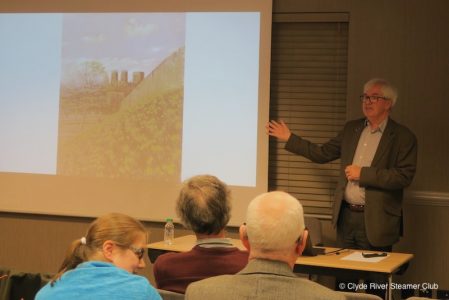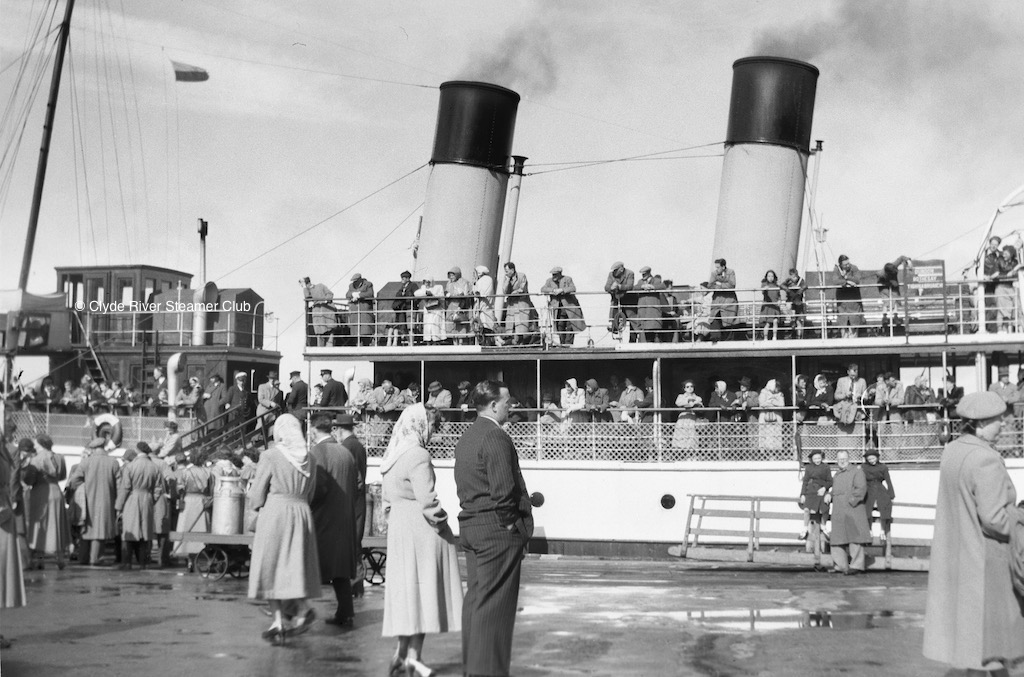
Childhood holidays in Arran: the turbine Glen Sannox boards passengers at Brodick in the summer of 1950 as she prepares to return to the mainland
Iain MacLeod has contributed much to the Clyde River Steamer Club over the years. His richly illustrated talk at Jurys Inn on 11 March demonstrated once again his gift for delving into the past and bringing it alive. Here is a personal account of the evening’s proceedings from Stuart Craig.
Iain has considerable credentials for addressing the ‘steamer’ club. Born in York, he spent most of his youthful holidays on the Clyde coast, before launching into a teaching career that culminated at The Glasgow Academy, where he achieved the post of Deputy Rector. He was CRSC magazine editor for 15 years and served twice as president (1988-89 and 2008-09) — one of only six people to have ‘done the double’. It could have been seven but no one has asked me yet!
However, it is entirely Iain’s fault that I am sitting here typing this now, for I attended my first ever CRSC meeting in 1989 when Iain was our figurehead, and was so impressed with his performance that I joined the Club.
The title of Iain’s presentation, his 10th to CRSC, alluded to his age. He gave his one and only stumble when explaining this.
“Yes, I’m going to be 70 next year,” he muttered solemnly and then, regaining his equanimity, corrected himself. “Sorry no, next week, not next year!”
Iain is undoubtedly an historian – a mad-keen fan of day-to-day steamer comings and goings. And he set about illustrating, in the kind of detail that only an enthusiast can, the Clyde scene of 1950. These were the heady days before the coming of the car ferry.
As Iain explained, to take a car onto a ferry in 1950 required permission from the Marine Superintendent, who conveniently seemed to have forgotten to include both his phone number and address on the brochures of the day.
The number of steamers extant in 1950, and ably recalled one by one, was astonishing. I counted seven paddlers, nine turbines and four diesels. I’m probably missing some, for half way through Iain’s talk I ran out of fingers and toes. The pioneering King Edward was still around, then aged 49. Waverley was out as early as January. Arran Mail was still sailing, but in her last year – the only ‘steamer’ to finish her career that year.

Iain caught the steamer bug on board PS Caledonia, seen here making a rare postwar visit to Princes Pier, just along the quay from the Albert Harbour
Iain caught the bug (the ‘steamer nutter’ bug, not Coronavirus) at the age of six, on a trip aboard the paddle steamer Caledonia. “When I stand and look at Waverley’s engines, I am right back there, aboard Caledonia,” he said.
As well as being a scholar of Clyde steamer history Iain loves a good photograph. He seemed to gaze with great affection at each image as it appeared on the screen, as he methodically pointed out the less obvious features captured by the camera. We saw pictures of every steamer that sailed in 1950. They were captured on passage, at piers, from high above, and in limbo at their winter haven in Greenock.
“Visiting the Albert Harbour in Greenock, off season, was like a trip to Mecca,” Iain confided. Indeed one of his photos from the harbour was my favourite picture of the evening – an image of the turbines Queen Mary II, King Edward and Duchess of Montrose berthed side by side.
Some of the deck shots were superb, and the railheads were described in considerable detail “….because when you set off ‘doon the watter’ in those days, it was usually by train.”
The six railheads — Craigendoran, Princes Pier, Fairlie, Wemyss Bay, Gourock and Ardrossan — were illustrated and their layout explained using photographs and maps.

A remnant of James Williamson’s pre-1914 CSP fleet: Duchess of Fife at Gourock in 1950 with winter boarding
“Look at the magnificent sweep of Gourock Pier. The whole Williamson fleet of old could berth there at the same time!”
Iain’s talk was truly fascinating. His relaxed style and poise were appreciated by his considerable audience, which I noticed held an encouragingly larger number of women than usual.
Evidently he enjoys such presentations, although he is in need of a better system for holding his glasses in place.
His perceptive eye for fine detail was evident throughout: not just photographic detail, but the enigmatic elements of social history that clearly delight him.
This carried across to his audience, as we absorbed the facts he threw out at us.
Here are a few: the 17 dockers it took to load and unload Arran Mail on her one daily trip to Arran, the 51 crew required for Duchess of Hamilton, the 40-odd steamer calls at Dunoon Pier most days, Prime Minister Clement Attlee arriving on Cowal Games Day 1950 aboard PS Jupiter and being harangued by nationalists. So, what’s new? Well quite a lot, actually.
Iain finished by showing us just how filthy, smoky and unhealthy our city was — little wonder folk escaped to the coast. The steamers have all gone but for one, and for that we should be grateful. And we are very grateful to Iain for giving of his time to come back to Glasgow and speak to us.
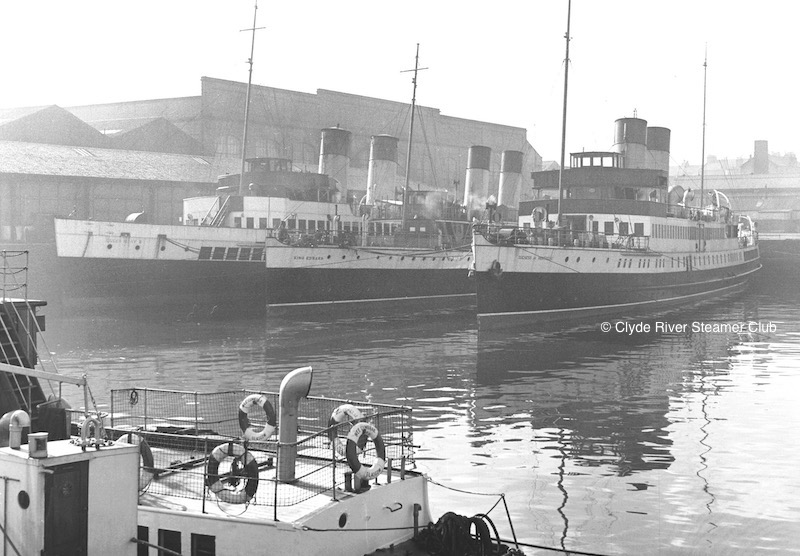
Stuart Craig’s favourite: Queen Mary II, King Edward and Duchess of Montrose huddle together in the Albert Harbour in 1950, with Wee Cumbrae in the foreground
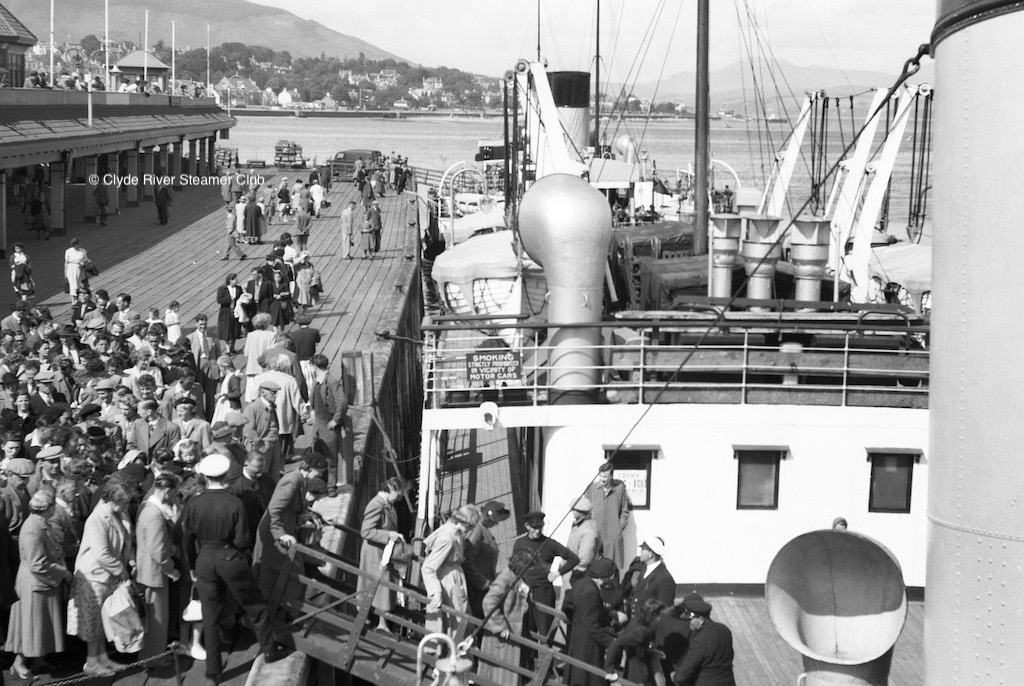
Afternoon scene at Dunoon: Marchioness of Graham, returning from a cruise to Lochgoilhead, prepares for the return voyage to Ayr, with Jupiter berthed astern of her. In 1950 Dunoon was still a hive of steamer activity

A placid scene at Brodick with Duchess of Montrose at the pier and a puffer at the entrance to the Strathwhillan Burn
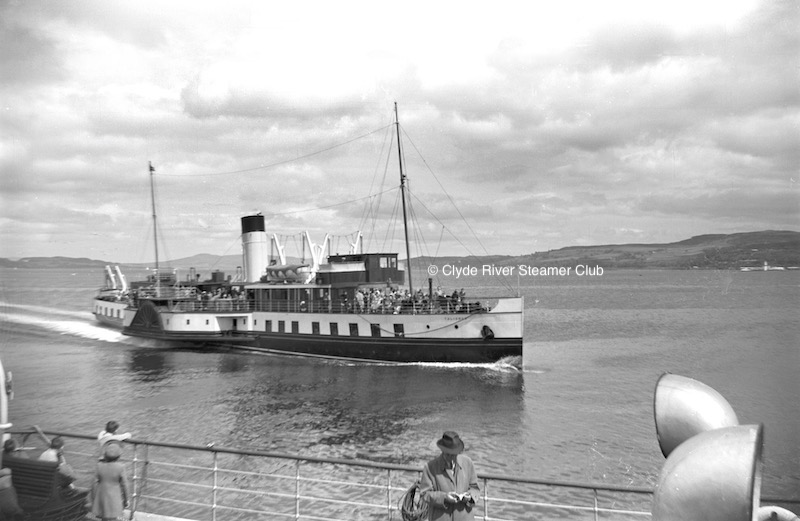
Black paddle boxes, brown deck houses, dodgers on the bridge wings: Talisman sweeps confidently into Dunoon Pier

Duchess of Argyll was still in service in 1950: this deck view looking aft captures her sweeping down the East Kyle

This view of Duchess of Montrose at Dunoon in 1950 was cited by Iain MacLeod as capturing the flavour of the postwar era, with crowded steamers (not motor ships) and plenty of activity. The photo is taken from the bridge of Duchess of Hamilton and shows Jupiter in the distance, passing Kirn
Read more of Iain MacLeod’s insights into Clyde steamer history:
Three steamer captains in court on the same day
Steamer profile: PS Queen-Empress
When intemperance got the better of Ivanhoe
TS Duchess of Hamilton — a steamer without equal?

Iain MacLeod (left) is congratulated after his talk by Lancashire-based Club member Derek Ferguson (right) and a first-time visitor to CRSC, Kay Waddell (centre)
Join CRSC here for £10 and take advantage of all the benefits! The annual Clyde Steamers magazine and Review 2018 are both imminent.
Published on 12 March 2020












